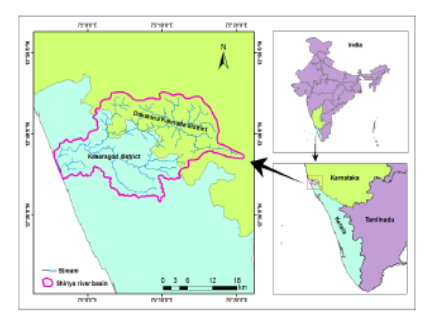


Indian Journal of Science and Technology
Year: 2022, Volume: 15, Issue: 35, Pages: 1691-1702
Original Article
K M Vidya1, A N Manoharan1
1Department of Post-Graduate Studies and Research in Geology, Government College Kasaragod, (affiliated to Kannur University), Kerala, Vidyanagar, Kasaragod, India
*Corresponding Author
Email: [email protected]
Received Date:09 May 2022, Accepted Date:31 July 2022, Published Date:07 September 2022
Objectives: The goal of this research is to calculate, compare and analyze the morphometric drainage parameters of Shiriya River Basin (SRB), Kasaragod, Kerala, using DEMs acquired by different satellite sensors and topographic data (SOI toposheet) for sustainable watershed development. Methods: The Arc GIS 10.3.1 software was used to measure linear, relief, and areal aspects of morphometry. The input data used for deriving the drainage network of the SRB were SOI toposheet (1:50000 scale), SRTM DEM (90m), Cartosat, ASTER and ALOS PALSAR DEM of resolution 30 m each. The relative error percentage of basic parameters derived from DEMs concerning the toposheet is calculated. A groundwater potential map is prepared using weighted overlay analysis of thematic layers (geology, geomorphology, slope, drainage density, lineament density and depth to water level). Findings: Present study revealed that the parameters derived from SRTM DEM data are more similar to those derived from toposheet. Most of the parameters obtained from each input DEM are more or less equal, and the minor variation may be due to varied data collecting and processing methodologies used for DEM creation. SRB is characterized by 6 th order stream with a dendritic drainage pattern, which is elongated and less susceptible to soil erosion. SRB has an intermediate texture and is in a mature stage of geomorphic evolution. Inference from the ground water potential zonation map indicates that major portion of the SRB has moderate ground water potential. Application/improvement: The study would be a valuable source for identifying water recharge sites, basin modelling, and groundwater prospect mapping. Novelty:This research has attempted to compare and analyze the morphometric parameters’ results from multisensor satellite data for sustainable watershed management. An attempt has been done to understand the relation between morphometric parameters and ground water potential of SRB using Groundwater potential zonation map.
Keywords: Drainage morphometry; Shiriya River basin; GIS; Karnataka; Kerala
© 2022 Vidya & Manoharan. This is an open-access article distributed under the terms of the Creative Commons Attribution License, which permits unrestricted use, distribution, and reproduction in any medium, provided the original author and source are credited.
Published By Indian Society for Education and Environment (iSee)
Subscribe now for latest articles and news.